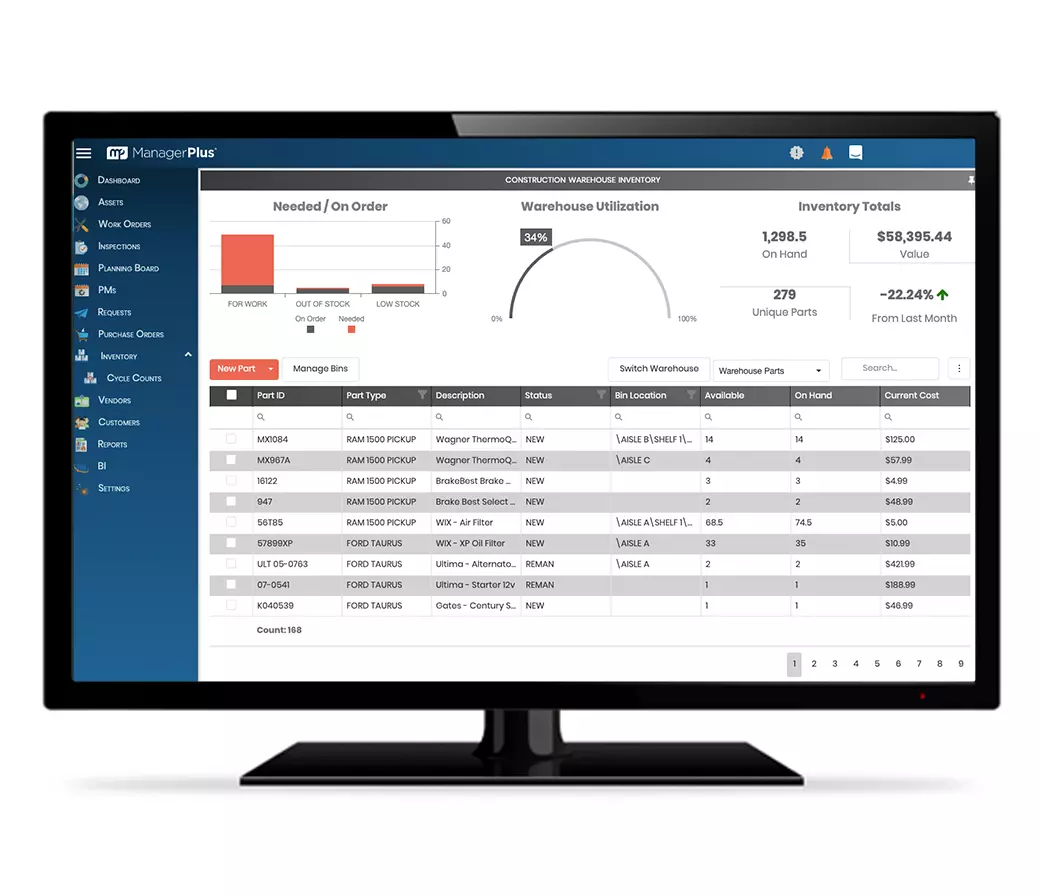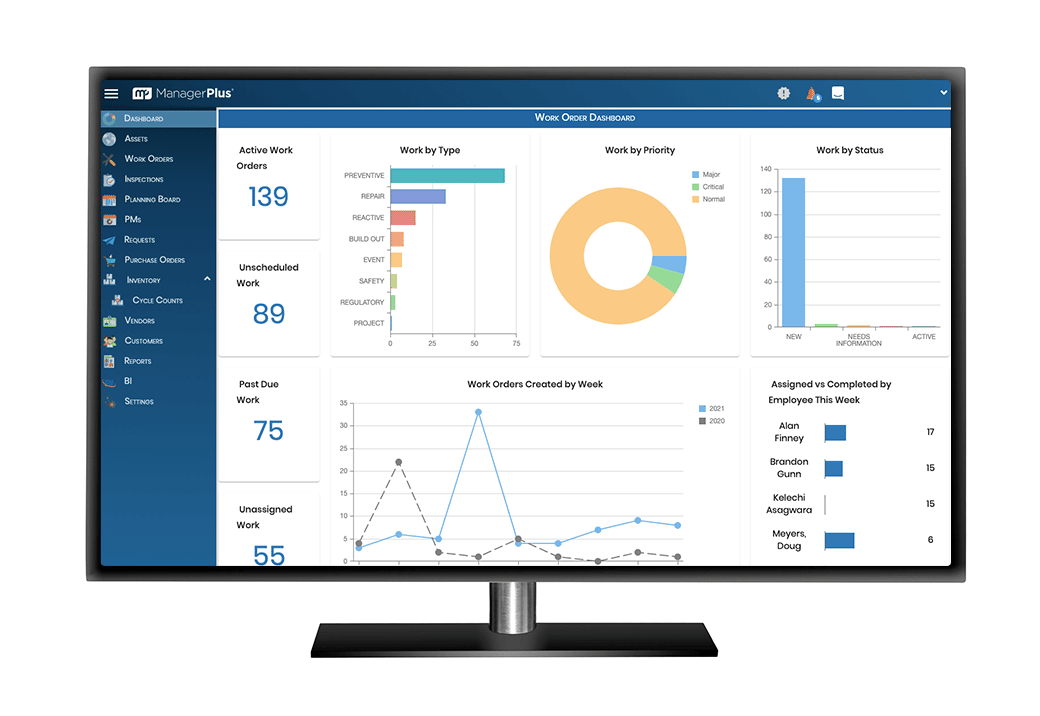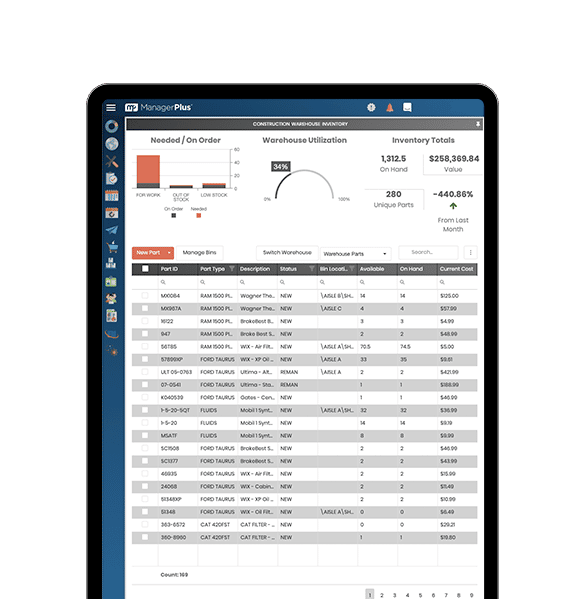The goal of any maintenance team is to fix equipment when it breaks, but what if you were able to anticipate equipment failures and fix them before they happen, all while helping your maintenance team operate more efficiently?
In today’s world, everything is connected, and data is king. Computerized maintenance management system (CMMS) software connects your maintenance team to your equipment and gives your team the tools they need to do their jobs better.
What is CMMS software?
A computerized maintenance management system (CMMS) is software that helps you streamline and optimize maintenance operations for assets and facilities. The goal of CMMS software is to help maintenance departments to reduce costs and boost productivity by, among other things, eliminating extraneous steps in maintenance workflows.
How does a CMMS work?
The heart and soul of a CMMS is data. When implementing the software at your organization, you’ll input a wide variety of data about your assets and equipment into the system so the program can help you automate processes to make your team more efficient.
Some of the main functions of a CMMS are:
- Work order management
- Preventive maintenance
- Inventory management
- Reporting
Automate your work orders to improve efficiency
Work orders are the lifeblood of every maintenance team, but while they keep your team on task, they can also be a main source of frustration and inefficiency.
Have you thought about how much of your team’s workday is wasted dealing with work orders? If you’re still relying on paper and spreadsheets to manage your work orders, you first have to sift through your email inbox to find the maintenance request, then you have to manually write up the work order, and finally, track down the technician to hand them the paperwork.
When the job is finished, if the tech doesn’t forget the work order at the bottom of their toolbox, they have to remember to walk it back to the maintenance office and either hand it to you or add it to the ever-growing stack of papers on your desk. Multiply this same inefficient workflow out across your entire team and that’s quite a few work hours wasted during the day, all toward simply trying to get work assigned.

With CMMS software, you automate that entire process. From the moment the request is received to when the tech closes out the work order, every part of that work order’s journey can happen automatically, saving you time and hassle. And if your CMMS is cloud-based, which it should be to be the most effective, you can follow along with every step of your work orders in real time. You know the instant it’s generated, assigned, accepted, and completed.
Develop and operate a robust preventive maintenance program
Preventive maintenance is one of the most efficient and cost-effective ways to maintain your assets and CMMS software can help you develop and maintain a strong preventive maintenance program. Preventive maintenance is proven to help lower the cost of maintenance on your assets while at the same time extending their life and usefulness, but it is not very effective if you don’t have the tools to run it properly.
The main goal of preventive maintenance is to prevent unscheduled downtime of your assets. While there may be times when you need to intentionally pull assets offline for whatever reason, unscheduled downtime is always something to avoid and by definition costs you more than you were expecting to spend in maintenance costs.
Preventive maintenance works by assigning routine maintenance tasks based on time of usage hours. The classic example is replacing oil on a work truck. As your operators drive the truck and update the mileage in the CMMS software, once the mileage hits a pre-determined number, the software automatically generates and assigns a work order to change the oil.
Without the software, you would have to manually track the mileage in a spreadsheet or on a piece of paper, hoping someone on your team remembers to change it when the time comes. Using CMMS software simplifies all of that by automating the entire process, so you don’t have to think about it.
With all of your preventive maintenance work orders living in your CMMS software, you can also easily keep track of how much time and money you’re putting into your assets so you can make better decisions on when to repair or replace them.

CMMS software makes inspections much more efficient as well. We already know that the best CMMS platforms are based in the cloud, but you should also look for one that has mobile apps and mobile connectivity. That way your operators can perform inspections from their smartphone or tablet and if an issue is detected, you can set the CMMS to automatically trigger a work order to fix the problem.
When it comes time for a compliance audit, all your inspection records are stored in your CMMS so you can quickly access them to prove compliance and avoid hefty fines.
Manage inventory more effectively
Managing inventory effectively can have a profound impact on your maintenance operations, particularly your costs. Effective inventory management can build off a good preventive maintenance program to help eliminate unplanned downtime on your assets.
You already know that unscheduled downtime is inefficient and expensive, but did you know that as much as 50% of unplanned downtime can be traced back to a lack of parts? No matter how good your technicians are, they can’t repair your equipment if they don’t have the right parts.
Effective inventory management is about having the right inventory in the right place at the right time and using good CMMS software can help you do that. When work orders are created that require specific parts, you can tell the software to automatically assign the correct inventory to the work order so it can’t be pulled for another work order.
Based on your supplier information and lead time, you can even set the CMMS up to prompt you when it’s time to order more inventory, so you don’t have to hold on to stock you don’t need, which means you aren’t paying to carry it.
Going back to the work truck example, if you have an upcoming PM to change the oil, but you’re out of oil filters and the lead time from your supplier is three days, you can set the CMMS up to prompt you four days before the PM is to take place so you can order more filters in time for them to arrive before your tech needs them.
Make better spending decisions with the right data
As anyone in business knows, you have to spend money to make money. The problem many organizations run into is that they don’t spend their money wisely. Many maintenance teams rely on an if-it-ain’t-broke-don’t-fix-it mentality for their maintenance operations, believing that simply not performing maintenance until absolutely necessary is the cheapest way to do it.
Many companies take the same approach to streamline their maintenance operations believing that if what they’re currently doing works, why should they spend money on a piece of software?
The truth is that the right data collected by your CMMS software can help you stretch your maintenance budget as far as it can go and make sure you get the most productivity out of your maintenance team and your equipment as possible.
CMMS software keeps track of all the maintenance your team performs, including the inventory they used, how long the job took, how often they performed certain tasks, and lets you generate detailed reports on that data so you can see exactly where your money is going and where you might be able to make improvements.

CMMS vs. EAM
Computerized maintenance management system (CMMS) software and enterprise asset management (EAM) software are both similar and do many of the same things, but there are some key differences, and it really comes down to the objectives of each platform.
CMMS helps companies track information about their maintenance operations so they can find ways to make their teams more efficient and improve asset uptime. EAM software does all of those things too, but it offers a much larger set of features that lets companies track data on the entire lifecycle of their assets as well.
Think of it this way: every EAM solution has a CMMS built into it, but CMMS software does not have the capabilities of an EAM solution.
Benefits and features of a CMMS
There are many benefits to using CMMS software:
Facility management – efficiently manage preventive and on-demand maintenance for your buildings and spaces.
Preventive maintenance – maximize uptime and availability by keeping your assets in prime condition.
Equipment maintenance – organize information, photos, and complete maintenance records in one place.
Work order management – ensure efficient follow-through on maintenance and repair tasks in real time.
Asset management – uncover asset performance metrics that drive better business outcomes.
Compliance management – avoid costly fines and litigation by easily proving compliance.
Mobile CMMS – collect and access data from anywhere with mobile-friendly software and mobile applications that even work offline.
Inventory management – track PPE, materials, and parts to avoid stocking issues.
Vendor management – manage third-party contractor work easily with no extra logins or licenses.
Maintenance reports – see customized data reports automatically or on-demand.
Inspection management – perform, track, and store inspection reports all in one always-accessible platform.
Benefits of cloud-based CMMS (SaaS)
In today’s world of connected technology, more and more companies are choosing to store their data and software in the cloud as opposed to having it all live on one computer or hard drive in an office somewhere (on-prem). This model of using software that is housed on the software provider’s servers and only accessing it when you need it is called software as a service (SaaS).
Some of the benefits of a SaaS CMMS vs an on-prem solution include:
- Less investment required
- Greater reliability
- Scalable
Put the costs back on the software provider
An easy way to think about some of the cost savings of using a cloud-based CMMS is to imagine it like Netflix. Imagine how much it would cost you to individually purchase every movie and TV show you wanted to watch on Netflix. Just one or two movies a month would likely cost more than a monthly membership which lets you watch everything for a flat rate.

Plus, you don’t have to deal with scratched disks, or broken DVD players, or any of that. If there’s a problem with the software, their IT team handles it so you don’t have to try to fix it yourself or bring in your own IT specialist.
The same is true for cloud-based CMMS software. There are no expensive computers or servers to purchase. Any time you need to use the program, you don’t have to fire it up on your machine and wait for it to load. You just log in and use it.
Your IT team doesn’t have to worry about outages or trying to fix any problems that arise because that’s all handled by the CMMS provider. You won’t have to hire any extra programmers, developers, or support personnel to keep your CMMS running.
Someone else takes care of it for you, freeing you to focus on the things you care about.
Greater reliability
Offloading your data and software to the cloud also offers much more reliability. Any good CMMS provider will automatically back up your data on a regular basis, so nothing ever gets lost and enterprise-level servers are almost always more reliable than the computer in your office.
The hardware and software that go into a software provider’s servers are designed to have an industry-standard uptime of 99.99%, and that’s only because it’s physically impossible to guarantee 100% perfection on anything.
With everything running on the provider’s servers, that also means any updates to the software are applied automatically. You don’t have to go to a website and download and install any programs or wait for the company to mail you a CD-ROM to install. It all happens instantly behind the scenes.
All this means that you can rest assured that your data is safe, secure, and always accessible.
Grow your CMMS with your business
Another big benefit to cloud-based CMMS programs is that they are built to grow with your organization. As your company gets bigger and acquires more assets and technicians, a cloud-based CMMS can easily add in all the new information, so nothing slows down.
As you grow, if you want access to new features of your CMMS, your provider can give you instant access to them to ensure you don’t miss a beat.
Industries that use CMMS
The benefits of CMMS software can be realized in almost any industry but some places where it can be most effective are:
- Education
- Construction
- Manufacturing
- Government
- Farm and agriculture
- Healthcare
- Facility management
- Energy
Next steps
If you’re ready to take advantage of all the benefits CMMS software has to offer, the best place to start is with a live, personalized, one-on-one demo of ManagerPlus CMMS software so you can see what it’s like to use it for yourself and ask any questions you may have.
If you already know you’re company could benefit from CMMS software, but you’re having trouble convincing some of the decision-makers at your organization, the following section is a brief summary of this article that you can share with them to help get them pointed in the right direction.
Executive summary
Computerized maintenance management system (CMMS) software is designed with one goal in mind: to help you save money and get more from your maintenance operations.
It helps optimize and streamline processes around things like:
- Work order management
- Preventive maintenance
- Inventory management
- Reporting
Using CMMS software allows your maintenance team to get out in front of repairs and prevent major issues from happening, so you don’t have to deal with the expensive fallout. If you’re still running things with paper and spreadsheets and letting your assets and equipment limp along until they break, start saving money and improving your operations with ManagerPlus.


